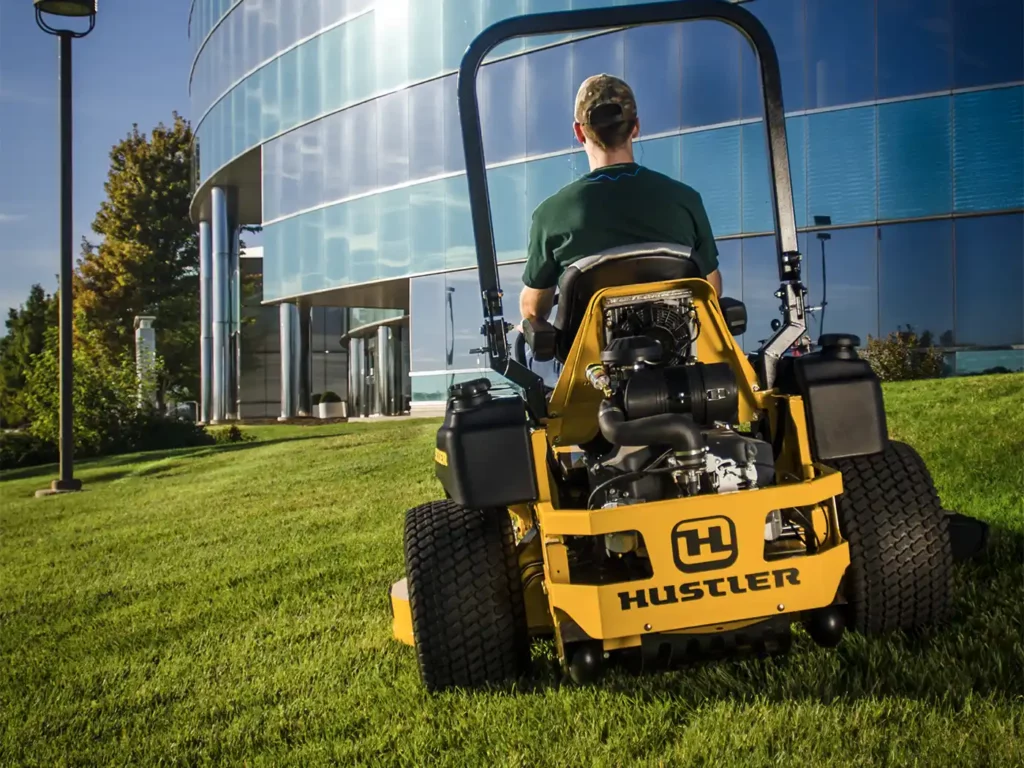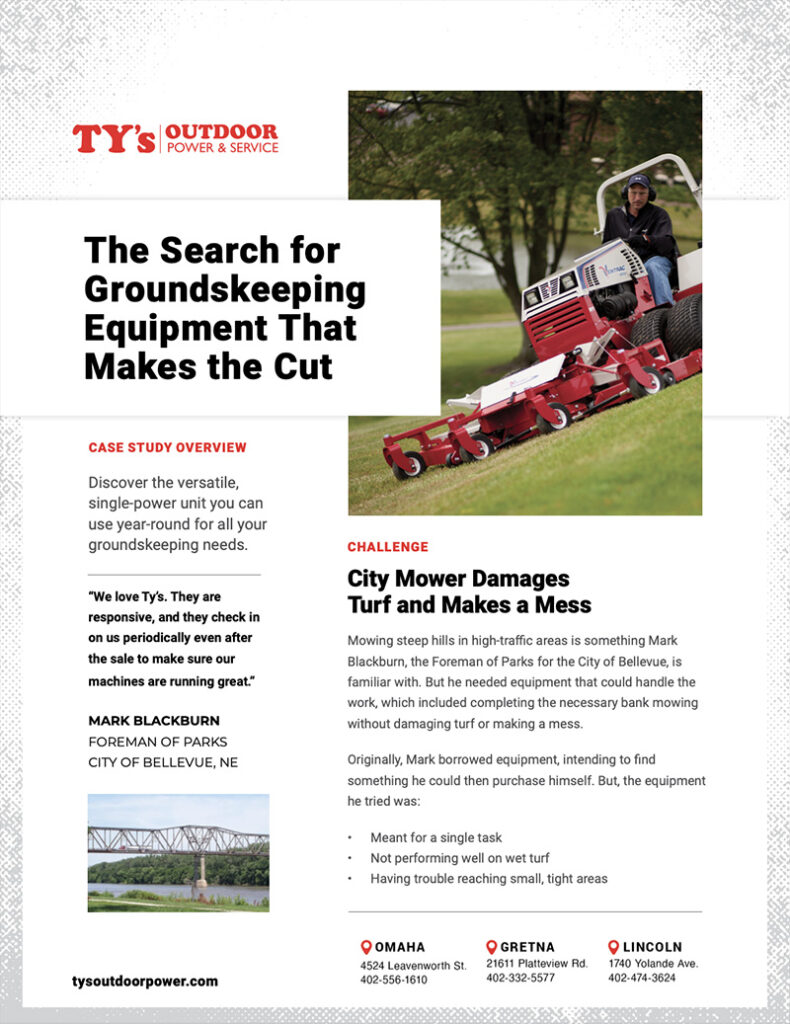Looking for some time-saving tips to take your commercial landscaping business to the next level this spring? Get ready for the growing season with these five time-saving tips that will help you streamline your operations, increase efficiency, and ultimately grow your business.
Whether you’re a seasoned professional or just starting, you can save time, energy, and resources while still delivering outstanding results for your clients.
Consistency is key for a successful landscaping business, and creating standard operating procedures (SOPs) can help ensure that tasks are performed efficiently and to your customers’ high standards. SOPs provide clear guidelines for your team, eliminating confusion and reducing the time spent on rework or correcting mistakes.
As you’re developing or revisiting your landscaping company’s SOP for the coming spring, let’s explore ways to optimize your equipment usage, streamline your communication, and maximize your workforce productivity.
Manage Your Time
Managing your time, and your employees’ time, effectively is crucial for maximizing your business’ efficiency and productivity. By effectively managing your time, you can ensure that you and your team are working efficiently and completing jobs promptly. This allows you to take on a higher volume of jobs and ultimately increases your revenue.
Landscaping projects often have specific deadlines that need to be met. When it comes to client satisfaction, quality and timeliness are the most important factors. Over nine in 10 consumers are more likely to make another purchase following a positive experience, so keeping customers happy is key to keeping (or renewing) their contract. (dynascape.com)
Rushing through projects due to poor time management can compromise the quality of your work. By managing your time effectively, you can give each job the attention and care it deserves, resulting in satisfied clients and positive referrals.
Start With Crew & Equipment Optimization
To make the most of your time and resources, it’s important to optimize both your crew and equipment to complete more jobs per day, maximizing your productivity and profitability.
Here’s how to optimize your crew and equipment:
1. Efficient Scheduling: Plan your crew’s schedule in a way that minimizes travel time between jobs. Group together jobs that are geographically close to each other, allowing your team to spend more time working and less time commuting.
2. Effective Delegation: Assign tasks based on each crew member’s skills and strengths. By utilizing their individual strengths, you can optimize productivity and ensure that each task is performed with the utmost expertise.
3. Regular Training: Regularly train your crew on efficient techniques and industry best practices. This not only improves their skills but also ensures that they are up-to-date with the latest tools and technology.
4. Regular Equipment Maintenance: Keep your equipment in top shape by implementing a regular maintenance schedule. This prevents unexpected breakdowns and ensures that your equipment is always ready to go when you need it. More on this important tip below!
5. Investment in Upgraded and Additional Equipment: Evaluate your current fleet and consider investing in newer models that offer improved efficiency. Upgraded equipment can help your crew complete jobs more quickly and with better results.
By optimizing both your crew and equipment, you can significantly increase your productivity and complete more jobs in a day. Implement these strategies, and watch your commercial landscaping business thrive.
Don’t Forget to Optimize the Order of Services
Optimizing the order of services is just as important as optimizing the people and equipment that you’ll use to provide those services. Here’s the recommended order for time efficiency:
1. Site Assessment:
Before starting any landscaping project, it is imperative to conduct a thorough site assessment. This involves evaluating the existing conditions, documenting issues, and flagging any potential challenges that need to be addressed before work gets started. For example, if a customer has a tree branch down in their yard, that needs to be dealt with before the mower starts running.
2. Clearing and Prep:
The next step is to clear the area of any obstructions. Move that tree branch from the above example, and keep an eye out for other hazards like errant landscaping rocks, blown trash or debris, and unwanted vegetation that might give your mower a hard time.
3. Hardscape Installation:
For new landscaping projects, installing hardscape elements like walkways, patios, and retaining walls should be done before planting any vegetation. This ensures that heavy machinery and construction work does not damage or disrupt newly planted areas.
Of course, for recurring service contracts like mowing, this step should already be complete. Consider making a note of any damaged or insufficient hardscape areas – this could provide an upsell opportunity later on!
4. Irrigation and Lighting Installation:
After the hardscape is complete, installing irrigation systems and lighting features is recommended. This allows for convenient access to water sources and maximizes the visual impact of the landscape design.
Again, for recurring service contracts, this is likely already taken care of. Still, it’s important to note where these features are to avoid damage during mowing, aeration, and other tasks. Plus, if you notice an opportunity for improvement or repair during your site assessment, you may have another opportunity to sell your existing client another service.
5. Planting & Seeding:
Once the hardscape and irrigation systems are in place, it is time to plant trees, shrubs, and flowers. Proper spacing and placement are crucial for the health and growth of the plants.
Don’t forget your preseason services! For your regular lawn care clients, you can offer seasonally appropriate seeding, fertilization, aeration, and weed-killing services. This is a win-win for you and your customer: their lawn looks better and stays healthier, and your ongoing mowing services can be completed faster and easier on the treated turf.
Maintain Your Equipment
Maintaining your commercial landscaping equipment is crucial for ensuring speed and efficiency in the long run. By sending your fleet for maintenance before the mowing season begins, you can save time and improve overall productivity:
1. Increased lifespan: Regular maintenance helps detect any potential issues early on and fix them promptly. This helps prolong the lifespan of your equipment, saving you from unnecessary replacement costs.
2. Preventive measures: Servicing your fleet before the mowing season allows technicians to inspect and clean for any dirt or debris that may have accumulated. They can also identify any worn-out parts and replace them, preventing breakdowns during important projects.
3. Enhanced performance: Well-maintained equipment operates at its optimal capacity, resulting in better performance and faster completion of tasks. This contributes to increased productivity and client satisfaction.
4. Cost savings: By investing in maintenance before the mowing season, you can minimize unexpected breakdowns and costly repairs. Regularly serviced equipment also tends to consume less fuel, further reducing your operational expenses.
In conclusion, maintaining your commercial landscaping fleet before the mowing season begins is a smart decision. It not only ensures the longevity and performance of your equipment but also saves you time, money, and potential disruptions to your business. Prioritize regular maintenance for a more efficient and successful landscaping operation.
Spring Maintenance for Landscaping Equipment
Spring is the perfect time to give your commercial landscaping equipment the care it needs. Whether you’ll send your fleet for service with a trusted partner or DIY in your own shop, here’s a list of essential maintenance tasks to ensure that your equipment is in top shape for the season:
1. Clean and lubricate: Start by thoroughly cleaning your equipment. Remove any dirt, debris, or grass clippings. Lubricate moving parts to prevent rust and ensure smooth operation.
2. Check blades: Inspect mower blades for damage or dullness. Sharpen or replace as needed to ensure a clean and precise cut.
3. Change oil and filters: Replace oil and filters to promote optimal engine performance. Refer to the manufacturer’s guidelines for the recommended intervals.
4. Inspect and clean air filters: Check air filters for dirt or clogs. Clean or replace them to maintain proper airflow and prevent engine damage.
5. Test the spark plug: Remove the spark plug and inspect for wear or damage. Replace if necessary to ensure reliable starts.
6. Check belts and hoses: Examine belts and hoses for signs of wear, cracking, or fraying. Replace any damaged components to prevent unexpected breakdowns.
7. Inspect tires: Check tire pressure and ensure they are properly inflated. Look for any signs of wear or damage, and replace any worn-out tires.
Remember, regular spring maintenance is crucial for commercial landscaping equipment to perform at its best.
Have the Right Equipment Ready to Go
Part of the reason that maintenance is so important is keeping your fleet ready to go. You want to have all your equipment in working order and ready to send out the door every morning.
When everything is prepared, the team can start working immediately without any delay, maximizing productivity. Plus, timely completion of projects is essential to ensure customer satisfaction. By having all your equipment ready, your crews can meet deadlines and deliver high-quality results, meeting or even exceeding client expectations.
There’s a safety component at play, too. Utilizing the correct equipment helps maintain a safe working environment. Each task often requires specific tools that ensure the team’s safety while handling various landscaping activities. By having everything set up in advance, potential accidents or injuries are minimized.
Part of having the right equipment ready to go is having enough equipment to go around. For example, zero-turn or riding mowers should be a priority investment for any lawn & landscaping company. Brands like Hustler and Cub Cadet both offer generous fleet discounts and a “fleet” can often start with just one unit. Financing is often available for qualified companies, as well.
If your crews are still using push mowers, you’re wasting a lot of time on every project. Zero-turn mowers, like those from Hustler or Stihl’s new electric option, can reduce mowing time by 30-50% on every site, meaning you could take on 3-5 new contracts and still pay for the same labor costs.
Commercial Landscaping Equipment
Of course, your crews rely on more than mowers and you’ll need a variety of commercial landscaping equipment to maintain and enhance outdoor spaces. Here is a list of other essential tools that are used for specific jobs:
- String Trimmers: Perfect for trimming edges and hard-to-reach areas for a polished look.
- Hedge Trimmers: Used to shape and maintain hedges, adding structure and privacy to landscapes.
- Leaf Blowers: Essential for clearing leaves and debris, ensuring a clean and presentable environment.
- Chainsaws: Required for cutting down or pruning larger trees and shrubs.
- Edgers: Designed to create clean and defined edges along sidewalks, driveways, and flowerbeds.
- Aerators: Used to create small holes in the soil, allowing air, water, and nutrients to reach the roots.
- Spreaders & sprayers: Ideal for applying seed, fertilizers, pesticides, and herbicides safely and effectively.
These commercial landscaping equipment form the backbone of any landscaping business, enabling your crews to create and maintain outdoor spaces your customers will love.
Try the Land and Expand Method
“Land and Expand” is a method that landscaping companies can use to grow their client base and increase their range of services. It begins with a simple contract, such as lawn mowing, that allows companies to establish a relationship with homeowners or businesses.
Once this relationship is established and your landscaping company has proven its quality and reliability, it can then offer additional services to these clients.
For instance, a landscaping company may start by offering lawn mowing services to a homeowner. By consistently providing excellent service and exceeding the client’s expectations, the company builds trust and credibility. This opens up opportunities to sell other services, such as landscaping design, tree trimming, or irrigation system installation And don’t forget off-season opportunities like snow removal!
This strategic approach helps landscaping companies gradually increase their range of services by initially establishing a strong foundation of trust and satisfaction with clients. It helps you scale sustainably, too; as contracts grow, you can invest in new equipment and crew members as they become needed, instead of all at once.
Complementary & Recurring Landscaping Services
When it comes to landscaping services, certain combinations work together seamlessly with your existing lawn care services. Recurring contract services like lawn mowing are your “Land” opportunities, and the complementary services can be offered strategically to “Expand” those contracts.
1. Lawn mowing and seasonal fertilization services: These two services go hand in hand to maintain a healthy and lush lawn. Land a contract with regular mowing services, then offer fertilization to provide essential nutrients for growth and weed control.
2. Aeration and overseeding services: These two services go hand in hand, and can be a great upsell opportunity for lawn care contracts. Aeration helps to improve soil health by allowing nutrients, water, and air to reach the grassroots. This service is often paired with overseeding, which involves spreading new grass seed over the lawn. Together, they can help enhance the overall health and density of the grass.
3. Weed control and preseason clean-up/maintenance: Weeds can quickly take over a lawn, compromising its appearance and health. Combining weed control treatments with preseason lawn maintenance and property cleanup can keep weeds at bay and ensure a well-maintained landscape throughout the growing season.
Help Your Happy Customers Help You Win New Customers
Happy customers can play a vital role in the growth and success of a landscaping business. Their positive experiences can help attract new customers in two main ways: through online reviews and by word of mouth in their neighborhoods.
Happy customers can share their satisfaction by leaving your business positive reviews on Facebook, Yelp, Nextdoor, and Google. These online reviews act as a virtual word of mouth, allowing potential customers to see the positive experiences others have had with the landscaping business. A glowing review about the excellent service, attention to detail, and beautiful landscaping can be incredibly persuasive to someone looking for a reliable landscaper. These positive reviews can contribute to the credibility and reputation of the business, making it more attractive to potential new customers.
It’s important to help your happy customers spread the word. For example, only about 20% of customers will leave a review without prompting, and 80% of online reviews are the result of an email follow-up after services. Having a simple marketing engine that emails each day’s customers to ask them to provide you with feedback is a great way to keep an ear out for customers who aren’t satisfied, too. After you receive that feedback, resolve any issues with unhappy customers and ask your happy customers to leave your business a review!
Of course, happy customers can also bring in new customers through word of mouth in their neighborhoods. When a homeowner has a stunning landscape that catches the eye of their neighbors, it often sparks conversations. They might mention the reliable and skilled landscaper they hired, emphasizing the top-quality work and excellent customer service they received. This word-of-mouth recommendation carries immense weight, as it comes from someone trusted within the community.
You can help word-of-mouth conversations start, too. This can be as simple as providing your customers with tasteful, logoed yard signs to display in their yards. Or, you can offer happy customers “good neighbor” discounts with coupons to share with their neighborhood. Your customer gets a percentage off their own services for each new customer who redeems their coupons!
Route Density
Those “good neighbor coupons” serve two purposes. The first is to build that word-of-mouth advertising. The second purpose is route density.
Route density is the number of lawn mowing contracts a company can land in the same neighborhood, and it’s crucial to time management and long-term growth.
Having multiple contracts in the same neighborhood greatly improves your crew’s efficiency. With a dense route, you’ll save time and fuel by minimizing travel distances between job sites. You’ll complete more jobs in a day, increasing productivity and profitability.
Route density enhances customer satisfaction, too. When a landscaping company serves multiple clients in a single area, they can offer prompt and convenient service. Customers appreciate having a reliable and responsive provider nearby, and this can lead to even more positive word-of-mouth referrals.
So how can your landscaping company increase its contract count in the neighborhoods you’re already working in? Here are a three strategies:
1. Offer those “good neighbor coupons” or referral incentives to existing customers who refer their neighbors.
2. Advertise a special offer through targeted, zipcode-based strategies like direct mail or social media ads that specifically mention the neighborhood. You can also consider delivering fliers door to door, but be careful that your fliers don’t become litter!
3. Establish partnerships with local real estate agents or homeowner associations for potential leads.
By focusing on route density, your lawn and landscaping business can maximize its efficiency, improve customer satisfaction, and successfully grow its presence in your target neighborhoods.
Ty’s Outdoor Power is Your Partner
Ty’s Outdoor Power has been partnering with commercial landscaping companies for over 20 years. We care about your business, and we’ll work hard to make sure you get the right equipment at a price your business can afford. Plus, we service what we sell (and what we don’t) to make sure your crews are always up and running. Check out our exclusive For the Pros section to explore more solutions for your lawn and landscaping companies. We’ve got your back!


